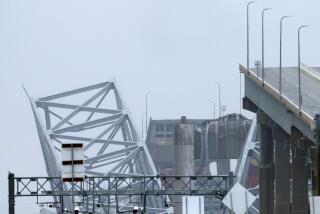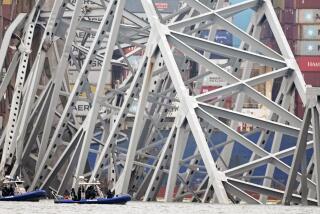OKLAHOMA CITY: AFTER THE BOMB : Heavy Machinery Tackles Rubble Pile : Recovery: Only one body is recovered, but equipment is expected to soon unearth more victims. Four children, 33 adults remain missing.
- Share via
OKLAHOMA CITY — As giant equipment Tuesday began to move huge chunks of concrete from the rubble pile that was once the Alfred P. Murrah Federal Building, the recovery of bodies was reduced to the slowest pace since the April 19 bombing.
Only one body was recovered Tuesday, but searchers remained confident that the earthmoving equipment soon will uncover a number of bodies crushed when nine floors of concrete and steel collapsed into a pile 1 1/2 stories high.
“I’m a little discouraged this afternoon,” said Ray Blakeney, director of operations for the state medical examiner’s office. “We’re moving huge pieces of concrete down there but the process is very slow.”
Blakeney, his eyes red-rimmed and his face sagging with fatigue, struggled to stick to his earlier prediction that the retrieval process will be completed by Friday. “We’re ready for this to be over,” he told reporters.
So far, 139 bodies have been recovered and all but two have been identified. Blakeney said that four children and 33 adults are still missing in the building. A nurse died during rescue efforts, raising the toll to 140.
A piece of equipment called a track hoe is being used to grab at concrete with its mechanical jaws at the end of a 30-foot hydraulic arm. The rumbling of the diesel engine that runs the device could be heard several blocks away in the chill air of a gray and windblown day.
With the work now being done increasingly by heavy equipment, fewer firefighters are needed. As of 6 p.m. Tuesday, search crews no longer will work through the night. Oklahoma City Fire Chief Gary Marrs explained that the building’s instability makes it unacceptable for firefighters to work at night when they might not realize that concrete is beginning to shift and possibly fall.
Blakeney told reporters that switching from a round-the-clock effort to daylight-only work is a further sign that officials believe all those still missing are dead.
Some firefighters continued to remove rubble Tuesday in an area of the disaster site considered relatively safe. But most of the remaining bodies are thought to be wedged beneath tons of concrete in an unstable “no-go” zone.
Two blocks from the site, haphazard memorials have given way to a small street-corner tent under which flowers, stuffed animals and even a bottle of bubble-blowing soap have been placed. People gathered there Tuesday.
Engineers with laser scopes are poised to sound warning horns if debris removal causes the building to shift, said Jeff Bekeris, a rescue worker from Orange County. And elevators on the building’s west side are working, allowing access to the roof.
There were numerous signs that this chapter of the nation’s worst terrorist incident is nearing completion.
The Salvation Army and Red Cross are shifting their efforts from crisis work to long-term assistance. The media army that has camped near the bomb site has begun to disperse. Fewer families are going to the church where they have been receiving psychological and religious counseling and other services from hundreds of volunteers.
The Rev. Mike Hays, one of the clergy assisting the families, said that they have shifted their focus to the future and are beginning to discuss a memorial service for all the victims. “They want closure,” he said.
The last of the 11 urban search and rescue teams summoned from around the nation by the Federal Emergency Management Agency will depart either today or Thursday.
In all, 650-plus rescuers from fire departments around the country, including the Los Angeles County Fire Department, were involved in the search effort, the largest in the nation’s history.
As the search and rescue teams departed, they left their city and state flags flying from the shattered building, which is topped by the American and Oklahoma flags.
Even with assistance from 11 teams, the brunt of the work on clearing away rubble has been left to the Oklahoma City Fire Department. So too was the grisly task of pulling the bodies out and wrapping them in sheets before they were taken to the medical examiner’s office.
“We’ve seen things nobody ought to have to see, in war or peace,” said Oklahoma firefighter Dennis Griffin, one of the first firefighters at the scene April 19 and--14 days later--still at work trying to remove victims. “It’s been a long, hard go, and I think a lot of us are exhausted and glad it’s almost over.”
Griffin was asked if any of his friends were killed in the blast.
“Everybody in that building was a friend of mine,” he said. “I’m from Oklahoma.”
More to Read
Sign up for Essential California
The most important California stories and recommendations in your inbox every morning.
You may occasionally receive promotional content from the Los Angeles Times.













